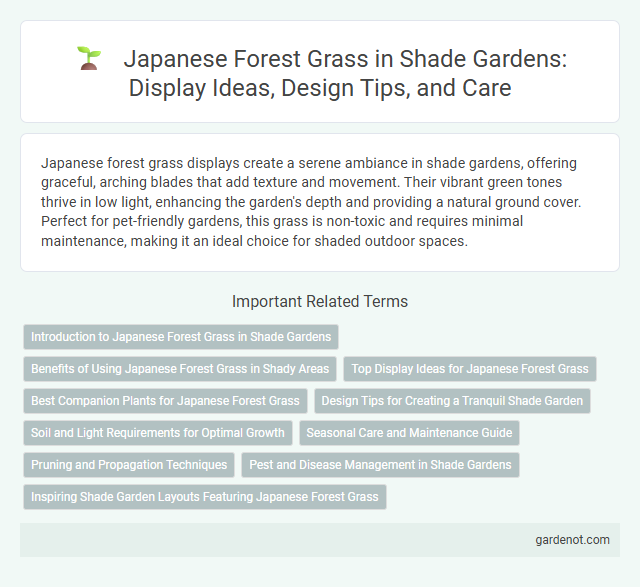Japanese forest grass displays create a serene ambiance in shade gardens, offering graceful, arching blades that add texture and movement. Their vibrant green tones thrive in low light, enhancing the garden's depth and providing a natural ground cover. Perfect for pet-friendly gardens, this grass is non-toxic and requires minimal maintenance, making it an ideal choice for shaded outdoor spaces.
Introduction to Japanese Forest Grass in Shade Gardens
Japanese forest grass (Hakonechloa macra) thrives in shaded garden environments, offering graceful arching leaves that add texture and movement to low-light areas. Its adaptability to partial to full shade and preference for moist, well-drained soil makes it an ideal ground cover or border plant in shade gardens. This ornamental grass enhances shade garden aesthetics through vibrant green foliage that can turn golden or bronze in autumn, providing year-round interest.
Benefits of Using Japanese Forest Grass in Shady Areas
Japanese forest grass (Hakonechloa macra) thrives in shady garden areas, offering excellent ground cover that suppresses weeds and reduces soil erosion. Its graceful, arching foliage enhances aesthetic appeal while requiring minimal maintenance and water, making it ideal for low-light conditions. The plant's tolerance to shade and adaptability to various soil types supports biodiversity by providing habitat for beneficial insects and small wildlife in shaded garden environments.
Top Display Ideas for Japanese Forest Grass
Japanese Forest Grass (Hakonechloa macra) thrives in shaded garden areas, offering striking bright green or golden foliage that adds texture and color contrast. Top display ideas include planting it beneath deciduous trees to highlight its cascading form, combining it with ferns and hostas for layered shade interest, or using it as a groundcover along shaded pathways for naturalistic appeal. Enhancing garden beds with Japanese Forest Grass enhances biodiversity and creates serene, low-maintenance landscapes ideal for shaded environments.
Best Companion Plants for Japanese Forest Grass
Japanese forest grass (Hakonechloa macra) thrives alongside hostas, ferns, and astilbes, which complement its delicate foliage and create layered textures in shade gardens. Ferns like Athyrium niponicum add airy fronds, while hostas provide broad leaves that contrast beautifully with Hakonechloa's arching blades. Astilbes offer vibrant flower plumes that enhance visual interest and support moisture-loving conditions ideal for Japanese forest grass.
Design Tips for Creating a Tranquil Shade Garden
Japanese forest grass (Hakonechloa macra) offers graceful, arching foliage that enhances a tranquil shade garden with its vibrant yellow-green hues and flowing texture. Positioning this ornamental grass near water features or along shaded pathways creates a serene focal point while providing natural ground cover that suppresses weeds. Combining Japanese forest grass with ferns and hostas improves plant diversity and maintains humidity, essential for a peaceful and balanced shade garden environment.
Soil and Light Requirements for Optimal Growth
Japanese forest grass thrives in well-draining, acidic to neutral soil rich in organic matter, ensuring proper moisture retention without waterlogging. It prefers partial to full shade, mimicking its natural forest understory environment, as direct sunlight can scorch the leaves. Maintaining consistent shade and moist, fertile soil promotes vibrant foliage and healthy growth in shade gardens.
Seasonal Care and Maintenance Guide
Japanese forest grass (Hakonechloa macra) thrives in shaded garden areas, requiring consistent moisture and well-drained soil to maintain vibrant foliage throughout the seasons. In spring, remove dead leaves and apply a balanced fertilizer to promote new growth, while summer demands regular watering and occasional mulching to retain soil moisture. Autumn care involves trimming back the plant to prevent disease and preparing it for winter by adding a layer of mulch to protect roots from frost.
Pruning and Propagation Techniques
Japanese forest grass (Hakonechloa macra) thrives with careful pruning, which involves trimming back dead or yellowing leaves in early spring to promote fresh, vibrant growth and maintain its graceful cascading habit. Propagation is effectively achieved through division in early spring or late autumn, ensuring clumps are split into healthy sections with ample roots to encourage robust establishment. Regular maintenance enhances the plant's lush texture and resilience, making it a standout in shade garden designs.
Pest and Disease Management in Shade Gardens
Japanese forest grass (Hakonechloa macra) thrives in shade gardens but requires vigilant pest and disease management to maintain its health. Common pests include slugs and aphids, which can be controlled using organic barriers and natural predators like ladybugs. Fungal diseases such as rust and powdery mildew can be minimized by ensuring proper air circulation and avoiding overhead watering in shaded, humid environments.
Inspiring Shade Garden Layouts Featuring Japanese Forest Grass
Japanese forest grass (Hakonechloa macra) offers vibrant texture and graceful movement ideal for shade garden layouts. Its bright green, cascading foliage enhances visual interest and contrasts beautifully with darker shaded plants like ferns and hostas. Incorporating Japanese forest grass creates serene, layered designs that thrive in low-light conditions while providing dynamic seasonal color changes.
Japanese forest grass display Infographic

 gardenot.com
gardenot.com